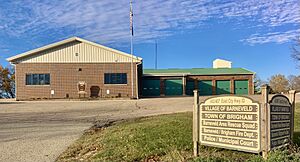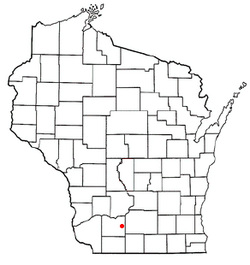Brigham, Wisconsin facts for kids
Quick facts for kids
Town of Brigham
|
|
|---|---|

Brigham Town Hall also the Barneveld Village Hall
|
|

Location of the Town of Brigham
|
|
| Country | |
| State | |
| County | Iowa |
| Area | |
| • Total | 64.1 sq mi (166.0 km2) |
| • Land | 64.1 sq mi (165.9 km2) |
| • Water | 0.0 sq mi (0.1 km2) |
| Elevation | 1,132 ft (345 m) |
| Population
(2000)
|
|
| • Total | 908 |
| • Density | 14.2/sq mi (5.5/km2) |
| Time zone | UTC-6 (Central (CST)) |
| • Summer (DST) | UTC-5 (CDT) |
| Area code(s) | 608 |
| FIPS code | 55-09600 |
| GNIS feature ID | 1582857 |
| Website | http://www.town.brigham.iowa.wi.us |
The Town of Brigham is a small town in Iowa County, Wisconsin, in the United States. In the year 2000, about 908 people lived there. A small community called Middlebury is also part of the town.
Contents
About Brigham's Land and Water
The Town of Brigham covers a total area of about 64.1 square miles (166.0 square kilometers). Almost all of this area, about 64.1 square miles (165.9 square kilometers), is land. Only a tiny part, about 0.04 square miles (0.1 square kilometers), is water.
Who Lives in Brigham?
Population and Homes
In 2000, the town of Brigham had 908 people living there. There were 335 homes, and 262 of these were families. On average, about 14 people lived in each square mile of the town.
Most of the people living in Brigham were White (about 99%). A very small number were African American or from other backgrounds.
Families and Age Groups
Many homes in Brigham had children under 18 living there (about 36%). Most homes were made up of married couples living together (about 73%).
The people in Brigham were of different ages. About 26% were under 18 years old. About 32% were between 25 and 44 years old. The average age in the town was 39 years.
Money and Income
In 2000, the average income for a household in Brigham was about $57,500 per year. For families, the average income was about $65,208 per year.
A small number of families (about 4.8%) and people (about 5.5%) lived below the poverty line. This included some children and some older adults.
See also
 In Spanish: Brigham (Wisconsin) para niños
In Spanish: Brigham (Wisconsin) para niños

